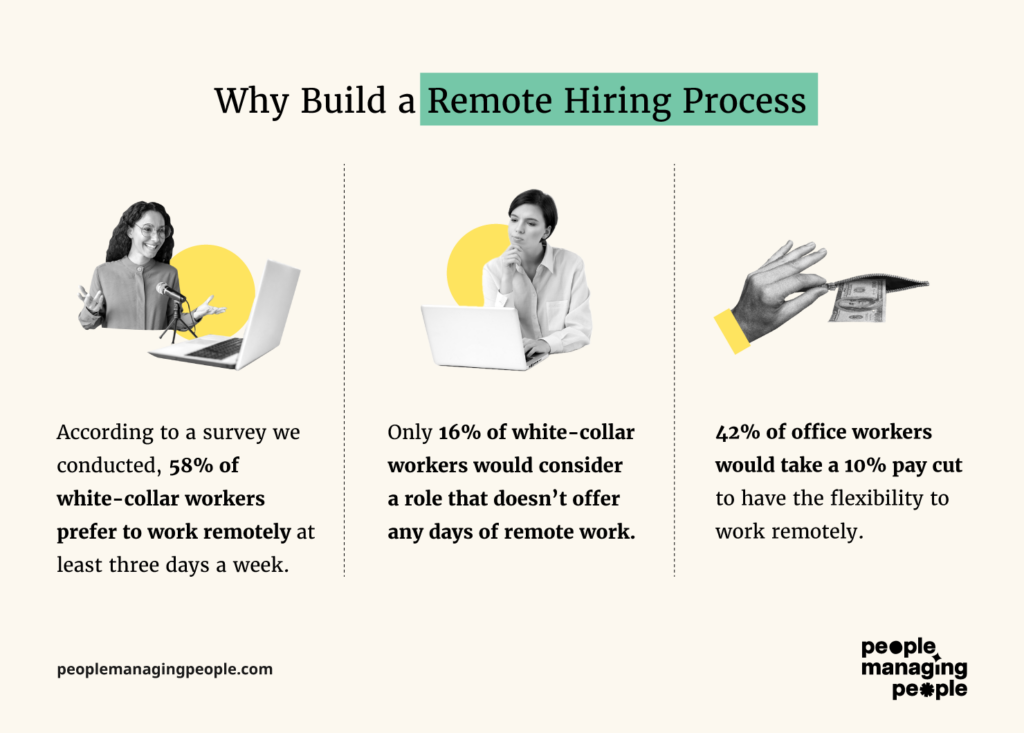As businesses increasingly recognize the benefits of a geographically dispersed workforce, the need for a well-structured remote hiring process has become more critical whether you're a startup aiming to tap into a global talent pool or an established company looking to adapt to new work norms.
This article will guide you through the intricacies of remote hiring, from defining job roles and sourcing candidates to conducting virtual interviews and onboarding new hires.
What is Remote Hiring?
Remote hiring refers to the process of recruiting and onboarding employees who work from locations outside of a traditional office setting.
Driven by demand, advancements in recruiting technology, the growth of HR services like employers of record, and changing work preferences, more companies are implementing a remote hiring process than ever before.
Why Build a Remote Hiring Process?
The shift towards remote work is more than just a trend—it's a transformation in how businesses operate. Embracing remote hiring allows companies to access a global talent pool, reduce overhead costs, and enhance employee satisfaction and productivity.

You can simplify the remote recruitment process by using recruitment systems for small business tailored to your needs.
How to Prepare for Remote Hiring
Just like you have to set the table if you want to enjoy a formal meal, you’ll need to take stock of your current processes and establish some best practices to develop an effective process for remote hiring.
Part of that will be developing a process checklist for teams to follow. Here are some steps to help you understand what should be on that checklist to help your team succeed.
Defining job requirements and expectations
When preparing to hire remotely, it's important to clearly define job roles, responsibilities, and expectations. Remote positions often require strong communication skills, self-discipline, and the ability to work independently.
Clearly outlining these requirements helps attract candidates who are well-suited for remote work environments.
Creating a remote-friendly job description
Writing an effective job description for remote positions involves highlighting remote-specific benefits like flexible hours and geographic independence.
Emphasize communication expectations, preferred time zones, and any necessary technical requirements to ensure alignment between the company's needs and the candidate's capabilities.
Setting up the right tools and technology
Successful remote hiring relies on leveraging the right tools and technology. Video conferencing platforms facilitate virtual interviews, while applicant tracking systems (ATS) streamline the recruitment process.
Collaboration tools like Slack or Asana foster team communication and project management, essential for remote teams' success.
Sourcing and Attracting Remote Talent
Finding and attracting talent that wants to work remotely isn’t much of a challenge in 2025. Rather, finding folks who want to commute and work in co-located spaces is inevitably a far more Herculean task.
Need proof? Simply post a remote position on any highly trafficked job board and watch the applications that roll in.
Leveraging social media and networking
Social media as a recruiting tool is growing in popularity. Platforms like LinkedIn, Twitter, and Facebook can help you reach remote candidates by engaging with relevant communities and groups.
You can also use job board software to share job postings, and showcase your company's remote work culture to attract passive candidates interested in remote opportunities. Specialist candidate sourcing tools can help you find new channels and compare their efficacy.
Employee referral programs
Implementing an employee referral program encourages current employees to recommend qualified candidates for remote positions.
Referrals often result in higher-quality hires who are a good cultural fit and can contribute effectively to remote teams.
Tip: Use employee referral software to automate the referral process and make it easier for workers to refer qualified candidates for open positions within the company.
Screening and Interviewing Remote Candidates
Once you identify candidates for a remote position, you then have to go through a process of screening and interviewing that is a little different than how you did this a decade ago.
Initial screening and assessment
Effective initial screening involves reviewing resumes and conducting skills assessments tailored to the position's requirements. Resume screening software can work hand-in-hand with ATS systems to ensure a smooth and efficient recruitment experience.
You can assess skills in an initial conversation, but if the job opening garners a lot of interest, it’s good to add another layer of screening to the process that may have previously taken place in a first interview.
A good example is having every candidate provide a written answer to three targeted questions or prompts tailored to their role within a certain word count.
Let’s say you’re hiring for a manager position. What you ask may include questions such as:
- Tell me about a time you had to make an unpopular decision.
- Have you ever had to set goals for an entire team? If so, how did you establish those goals and communicate them?
- How do you resolve disagreements between colleagues or with fellow leaders who challenge your direction?
You might normally associate these with questions to be asked further down the interview funnel, but by providing the answers to interviewers beforehand, they can ask more targeted follow up questions and show the candidate that their answers were noticed.
The goal is to gain substantive insight into how a person approaches workplace problems and how they've been effective in the past. Hopefully, this ensures that once you get to a phone or video interview, you're confident they're at least a good fit for being a candidate.
In our example, the questions can give you a sense of a few important things, including the candidate’s:
- Communication style
- Approach to problem-solving
- View of their own experience
- Suitability for your culture
- Confidence in answering difficult questions.
For each role you hire for, the questions will be different. Be imaginative, and attempt to develop questions that when answered, will give you a sense of the candidate’s characteristics that you want to evaluate.
Conducting Remote Interviews
Conducting remote interviews requires careful planning. You’ll want to establish a structured interview process using video conferencing tools for face-to-face interactions to allow candidates an opportunity to show their communication style and ability to work remotely.
Ensure all interviewers are aligned on evaluation criteria and know where they sit on your recruiting process flowchart.
If you use a collaborative hiring process, creating a consistent interview experience regardless of who the candidate is interacting with is an important part of building your employer brand and a positive rapport with new hires.
As with in-person interviews, interview scheduling software can automate this part of the process.
Assessing Technical and Soft Skills
Evaluate both technical skills relevant to the job and soft skills crucial for remote work, such as time management, collaboration, and adaptability.
Assessing these skills ensures candidates can thrive in a remote work environment and contribute effectively to remote teams. Some examples of skill assessments might include:
- Coding challenges
- Writing samples
- Presentation decks outlining approach to role
- Simulated work scenarios.
The Hiring Decision
Okay, the hard part is done. You’ve interviewed a good number of candidates and you’ve narrowed it down to a few strong ones who check the boxes for what you need from the person who ultimately fills the role. Now, it’s decision time.
Here are the next steps in your process.
Compare candidates
Compare remote candidates objectively using predetermined evaluation criteria and scoring systems. Consider the most important factors for success in both the role and your organization. These include things such as:
- Experience
- Skills alignment with job requirements
- Cultural fit
- Remote work experience.
Checking references
Conduct reference checks just as you would with any other candidate to validate qualifications and assess their past performance and work ethic. The only additional component in this case is asking about how the person was able to work remotely.
Prepare specific questions related to remote work capabilities and collaboration to gather insightful feedback from referrals. Automated reference checking software can help here.
Extending the job offer
When extending a job offer to a remote candidate, provide clear, detailed contract terms, including salary, benefits, and remote work policies.
Onboarding Remote Employees
If your offer is accepted, it’s on to the next step; onboarding. Outline the onboarding process and set expectations for the candidate's integration into the remote team, from equipment delivery to a 30, 60, 90 day plan.
Preparing for day one
Before a remote employee's first day, ensure all necessary accounts, tools, and equipment are set up. Provide access to company resources and establish communication channels to facilitate a smooth transition.
Virtual onboarding process
A structured virtual onboarding process will include virtual orientations, training on company policies and tools, and introduce new hires to their remote team members to foster connection and collaboration.
Ongoing support and integration
Offer ongoing support to remote employees to help them navigate challenges and feel integrated into the company culture.
Schedule regular check-ins, provide opportunities for professional development, and encourage participation in virtual team activities to foster a sense of belonging.
Best Practices for a Successful Remote Hiring Process
A good remote hiring process is a reflection of company culture like any other process. To make it more effective and attractive to remote candidates, adopt these three best practices into your process.
Leverage asynchronous communication
Asynchronous communication allows team members and candidates to contribute and respond at their convenience, which is particularly useful across different time zones.
Provide timeframes for responses so that candidates aren’t left waiting, but inform candidates that asynchronous working is a company value that will be applied in this process.
Tools like email, project management software, and collaborative platforms can help maintain productivity without requiring real-time interactions. This approach reduces the pressure of immediate responses and allows for more thoughtful and thorough contributions.
Building a remote-first culture
Cultivate a remote-first culture by prioritizing inclusivity, trust, and collaboration among remote and on-site employees.
A big part of remaining inclusive is how you construct meetings, particularly if you’re operating under a hybrid work model. There’s a ton of technology that can help you make meetings more inclusive, but at the end of the day, it’s the practices you implement that will make the biggest difference.
Check out our recent podcast episode on adapting your meetings to suit a hybrid workforce.
Continuous improvement
Continuously evaluate and refine your remote hiring process based on candidate feedback and performance metrics.
Identify areas for improvement, opportunities to automate or implement new technology solutions, and adapt to evolving remote work trends to optimize hiring outcomes.
Key Takeaways
- Remote hiring is essential in today's business landscape, allowing companies to access a global talent pool, reduce costs, and enhance employee satisfaction. The growing demand for remote work means businesses must adapt their hiring processes to attract and retain top talent effectively.
- A well-structured remote hiring process includes clearly defining job roles, leveraging appropriate tools and technology, and using targeted job descriptions to attract remote candidates. Effective initial screening, remote interviews, and thorough skills assessments ensure the selection of suitable candidates for remote roles.
- Building a remote-first culture that prioritizes inclusivity, trust, and collaboration is crucial for the success of remote teams. Additionally, continuously evaluating and improving the remote hiring process based on feedback and performance metrics helps businesses stay competitive and responsive to evolving remote work trends.
Want to keep up with all the latest trends in remote work and hiring? Sign up for the People Managing People newsletter to get all the latest insights, tips and news straight to your inbox.




